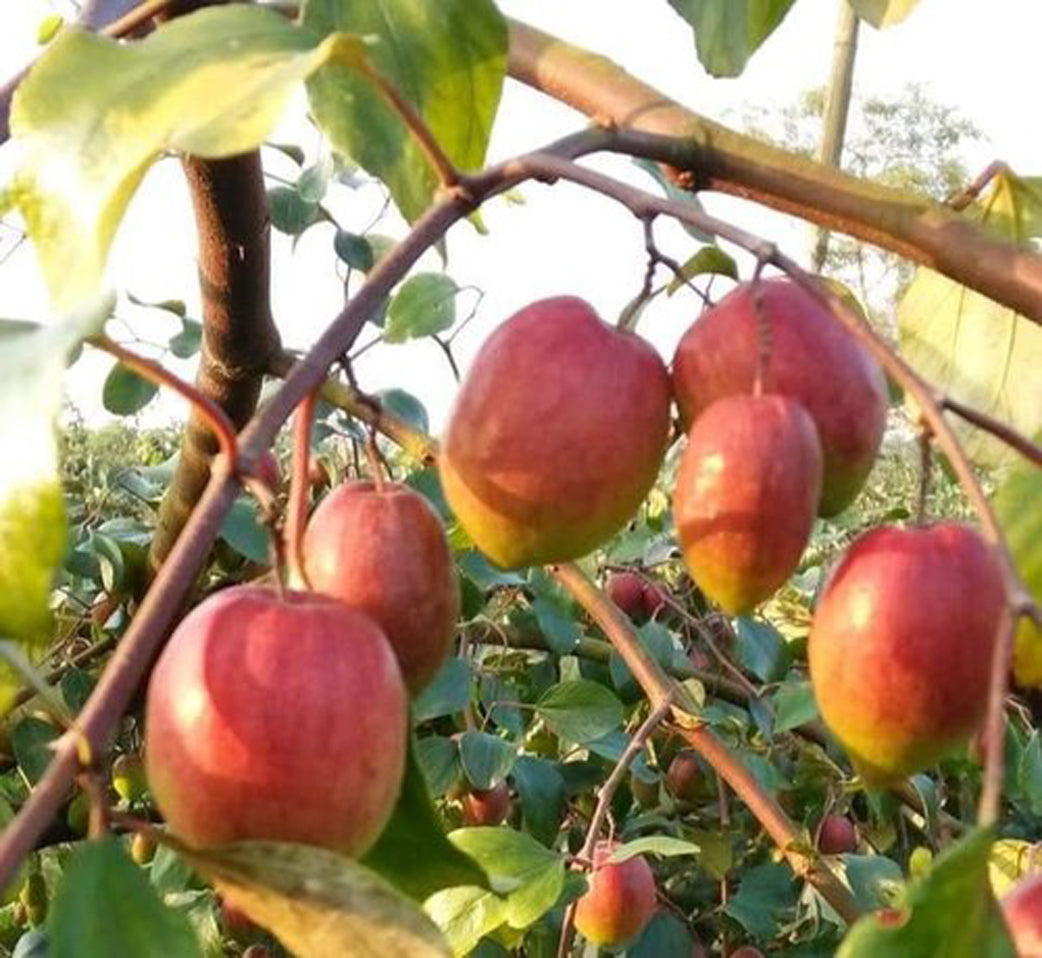Love it? Add to your wishlist
Your favorites, all in one place. Shop quickly and easily with the wishlist feature!
[message]
[title]
[message]



Veliyath Gardens
Couldn't load pickup availability
A Time-Honored Tree Offering Sweet Fruits, Natural Remedies, and Garden Charm
Among nature’s quietly enduring treasures, the Ber Apple Red Fruit, botanically identified as Ziziphus jujuba, is a plant of deep cultural and medicinal heritage. Known for its glossy red fruits and nutritional richness, this fruit-bearing tree has travelled centuries across Asia and the Middle East, finding favor for both its taste and healing powers.
At Veliyath Gardens, we bring you this robust fruit plant known for producing aromatic, sweet-red fruits that have sustained generations. Whether you’re a gardener, a wellness seeker, or a lover of traditional plants, this tree stands as a rewarding companion in your green space.
Botanical Name: Ziziphus jujuba
Common English Name: Ber Apple Red Fruit
Popular Regional Names:
India: Lal Ber, Badari
China: Hongzao (Red Jujube)
Korea: Daechu
Middle East: Nabq or Sidr
Each name carries its legacy, testifying to the plant’s widespread presence and revered status across various traditional systems of medicine and rural economies.
The tree is a spiny, medium-sized, deciduous shrub or tree, adaptable to dry and tropical climates.
Its dense foliage and arched branches make it appealing in gardens or orchard borders.
The fruits vary in shape, from round to oblong, and develop a striking red hue as they ripen.
Flesh is crisp and white, slightly juicy when under-ripe, and tender and sweet when fully matured.
The thin, glossy skin encloses an edible pulp that offers both freshness and subtle sweetness.
The Ber Apple Red fruit has a sweet, slightly tangy flavor, reminiscent of a crisp apple when young and of dates when mature.
It becomes more sugary and soft as it ripens fully.
Culinary Traditions:
Consumed raw or sun-dried as a snack
Used in making herbal teas and infusions, especially in China and Korea
Blended into syrups, sweets, and jams
Added to savory stews in Middle Eastern cuisines for a sweet undertone
Its adaptability in the kitchen makes it a versatile fruit that blends nutrition with flavor.
The Ber Apple Red fruit is low in calories but high in essential nutrients, making it a favorite in health-conscious diets.
Rich in dietary fiber: Aids digestion and supports a healthy gut
Contains potassium: Supports muscle function and cardiovascular health
Vitamins C and A: Enhances immunity, promotes skin health, and improves vision
Essential amino acids: 18 of the 24 amino acids are present, supporting overall body growth and cellular repair
Natural sugars and antioxidants: Deliver clean energy while fighting oxidative stress
For centuries, Ber fruits have been part of traditional healing systems, such as Ayurveda, Traditional Chinese Medicine (TCM), and Unani. The fruits, bark, leaves, and seeds are used in various ways:
Soothes insomnia and anxiety
Strengthens bones and joints
Aids in wound healing and skin repair
Used for liver detox and appetite stimulation
Believed to support heart health and memory enhancement
Modern research continues to validate these ancient applications, emphasizing its place in natural wellness.
Growth Type: Medium-sized, upright shrub or small tree
Soil: Thrives in sandy to loamy soils, even in marginal lands
Watering: Minimal watering once established; drought-tolerant
Light: Prefers full sunlight for best fruiting
Fruit Bearing Time: Begins to bear fruit in 4 to 5 years
Pruning: Occasional pruning promotes better shape and higher fruit yield
This tree is an excellent choice for gardens with limited water supply or arid soil conditions. With moderate care, it yields generously year after year.
Fresh fruits can be stored for 7–10 days at room temperature or refrigerated for up to two weeks.
Sun-dried fruits are a staple in many regions and can be preserved for months.
Traditional practices include turning the fruits into dry sweets, candied slices, or medicinal tonics.
Drying enhances its natural sugar content, making it a preferred ingredient in herbal preparations and winter snacks.
In China, the red jujube is considered a symbol of fertility and good fortune, often included in wedding rituals.
In India, it is associated with spiritual offerings, especially during festivals like Maha Shivratri.
The leaves are offered to deities, and its presence in rural homes is seen as a sign of abundance and health.
In Korean and Middle Eastern medicine, the fruit is boiled and consumed as an immune-boosting tea.
The Ber Apple Red plant isn’t just a fruit tree—it’s part of generations of stories, health traditions, and ceremonial life.
The Ziziphus jujuba tree rewards even the minimal gardener with its resilient nature, seasonal beauty, and healing fruit.
Its nutritional strength and historical depth make it a meaningful addition to home gardens, wellness farms, and herbal corners.
It invites birds, bees, and beneficial insects, enhancing biodiversity around your garden.
Whether you are growing it for its fruit, for traditional value, or for its ease of care—this tree is a dependable choice.
At Veliyath Gardens, we handpick and nurture plants that combine heritage, health, and horticultural elegance. The Ber Apple Red Fruit Plant is no exception. Its story is long, its benefits are proven, and its presence is enriching.
If you're looking to introduce a tree that delivers both taste and tradition, this is your perfect pick. Grow it, taste it, preserve it—and be part of a living legacy.
Growth Type: Medium-sized, upright shrub or small tree
Soil: Thrives in sandy to loamy soils, even in marginal lands
Watering: Minimal watering once established; drought-tolerant
Light: Prefers full sunlight for best fruiting
Rich in dietary fiber: Aids digestion and supports a healthy gut
Contains potassium: Supports muscle function and cardiovascular health
Vitamins C and A: Enhances immunity, promotes skin health, and improves vision
Essential amino acids: 18 of the 24 amino acids are present, supporting overall body growth and cellular repair
The tree is a spiny, medium-sized, deciduous shrub or tree, adaptable to dry and tropical climates.
Its dense foliage and arched branches make it appealing in gardens or orchard borders.
The fruits vary in shape, from round to oblong, and develop a striking red hue as they ripen.




